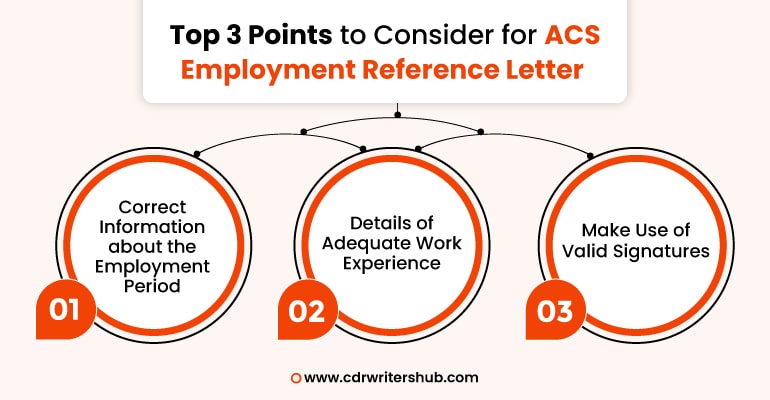What is the role of an employment reference letter in an ACS RPL report?

What is the role of an employment reference letter in an ACS RPL report?
RPL report is a compulsory report that needs to be prepared for skill assessment. It is frequently undertaken by applicants who have no prior ICT experience or tertiary ICT qualifications. Before being declared eligible to migrate to Australia, the Australian Computer Society (ACS) will review your competence evaluation. As a result, ACS provides applicants who would not otherwise meet the ICT criteria with the opportunity of assessing their knowledge and abilities via RPL reports via ACS Australia Migration Skills Assessment. We’re already familiar with the RPL report format. If you have any questions, please consult the document checklist.
For migration purposes, if your academic level qualifications and work experience are at a professional ICT level and are closely related to the required occupation (ANZSCO), the ACS ICT skills assessment will be considered; nonetheless, the skill and knowledge must be matched. Your credentials and expertise are initially reviewed or investigated to determine AQF comparability based on Australian national education criteria. Following the development of the AQF, the course modules are reviewed to define the professional ICT content of your certification or to assure full knowledge. Each unit is examined to determine whether or not it is an ICT professional unit.
In Australia, the ACS is the highest body representing the ICT sector. It provides authoritative, independent knowledge and technology insights. It also develops relevant technology capacity and capability, ensuring that technology is adopted by commerce, government, and society to benefit them.
An RPL report must contain a letter of recommendation from a previous employer. As previously indicated, RPL reports are generated for applicants who lack ICT experience or whose ICT abilities are insufficient to meet the Australian Computer Society‘s criteria. To establish appropriateness, ACS assesses people’s talents and job experience.
An employment reference letter is a crucial component of the RPL report for non-ICT professionals since it shows what they have learnt during all those years of experience that are comparable to an ICT degree. Your work reference letter will include information about your educational background, previous employment history, competencies, and talents. When submitting an RPL report, you must attach a reference letter from your employer. The Australian Computer Society is in charge of evaluating your proficiency, and the ACS criteria must be followed.
What is skilled employment for RPL report?
Table of Contents
For skill assessment purposes, an employment opportunity with at least 20 hours per week and remuneration can be considered. The task to be assessed must be performed at the appropriate level of depth and complexity for the stated employment. The level of skill required should be reflected in the compensation. Please keep in mind that unpaid/partially paid leave or volunteer activities will not be considered paid labour at the required skill level of a chosen occupation for skills assessment purposes.
If you meet the ACS qualification requirements, your employment will be categorised as Skilled Employment, and you will be eligible for migration points. Work experience required to satisfy the qualifying criteria, on the other hand, is NOT considered Skilled Employment and so ineligible for migration points.
Format for employment reference letter
The employment reference letter includes your educational qualifications, professional experience, abilities, and competence. When submitting their RPL report, candidates must attach a work reference letter from their previous employer. The ACS society will examine your RPL report based on your work history and experiences.
An employment reference letter may also help you obtain a favourable verdict from the ACS. To be considered appropriate for migration skills evaluation, work experience must be at the professional ICT level and related to the designated ANZSCO occupations. You must have professional ICT experience relating to your chosen occupation to be eligible for migration skills evaluation.
The following rules should be followed when writing an employment reference letter:
- Throughout the entire job period, dates should be in the format DD/MM/YYYY.
- Work position in the given field
- During the workplace, you accomplished certain tasks.
- Positions and responsibilities from previous positions should be included if necessary.
- Hours worked each week and part-time status.
- Detail of the work location
- Organizational letterhead signed by an authorized individual (digital signatures are acceptable and must be verifiable) is to be included.
Points to remember in an employment reference letter
- When the reference letter is written by an employer, the letter should include the phrase “To Date” and the date when the reference letter was written.
- Your experience will only be analyzed as of the date you submit your application.
- According to your work reference, relevance to the occupation is determined by descriptions of responsibilities.
- If the dates or responsibilities are unclear or subject to interpretation, the work episode will be declared unfit.
- Work done in conjunction with a qualification is not considered skilled employment, but is recorded as “Concurrent Employment.”
- A candidate’s work experience obtained before the age of 18 will not qualify them for skilled employment and will be reported as ‘Not professional level ICT experience.’
- References that do not specify particular responsibilities will be rated as “Not Suitable due to insufficient information.”
- Referrals containing copied and pasted tasks from ANZSCO will not be accepted.
Each work episode demands the submission of a job reference letter. All references must provide detailed information from the firm about your obligations and abilities on the job. Your employer or someone authorized by your firm must sign your references. The name, job description, and contact information of the individual referred must be clearly stated.
How do you submit your employment reference letter?
Applicants must separate employment episodes in their online applications to highlight “Australia” and “Outside of Australia” work.
Employment in Australia: Each period of employment within Australia must be listed separately in the online application.
Employment Outside Australia: If you have worked for many employers or outside of Australia, your employment is divided into Australian employment episodes; each period of employment outside of Australia must be reported individually in the online application.
Assume you’ve worked for the same firm and in the same or very related occupation in a number of countries (excluding Australia). In such a scenario, it should be listed as a single period of employment outside of Australia on the online application.
When will your work experience be deemed inappropriate?
- Working for many employers at the same time
If the candidates work during one employment period while concurrently working during another, only one employment event is recognized at any time.
- ANZSCO is not connected to the ANZSCO that was nominated.
Based on the information presented in the papers, the indicated tasks were determined to be unrelated to the designated occupation.
- Inadequate documentation results in a failed evaluation.
If the material provided does not fulfill the standards of the Skills Assessment Guidelines or is inadequate to meet the assessment criteria, it will be labeled as unassessed.
- The lack of detail renders the work episode inevaluable.
The information provided is insufficient for us to make an assessment.
- Concerns About Result Letters
Candidates who want to know the outcome of their examination should contact the ACS through email, mentioning their Application ID reference number.
Top 3 points to consider for ACS employment reference letter
Consider the following scenario: you want a well-written job reference letter for the ACS RPL report. In such a scenario, CDR Writers Australia provides a platform through which you can obtain the best RPL report writing services and reference samples for your guidance. Below, we’ve highlighted crucial points to consider when writing your ACS employment reference letter.

Correct information about the employment period
The secret to success is to develop original, plagiarism-free content. Make sure you write about true employment experiences and don’t try to trick ACS. In addition, do not take information from internet samples. Any job experience you offer must be professional and related to the specified occupation, according to the ANZSCO code.
Details of adequate work experience
You must have adequate work experience before applying for the ACS skills assessment since ACS has determined the minimum work experience required to guarantee candidates fulfil the skill level criteria.
Only employment that satisfies the skill level standards qualifies for migration points as Skilled Employment. Remember to explain your job duties, tasks, and skillsets when submitting an employment reference, emphasizing all competency areas.
Make use of valid signatures.
The employer or an authorized representative of the business must sign/verify the job reference letter you provide. Specific information such as the name and status of the individual making the suggestion must be included. Using forged signatures on non-existent organizations may result in a prohibition from resubmitting the application.
What services do we provide?
Depending on your work experience and ANZSCO occupation, CDRWritersHub provides high-quality employment reference letters. We have a 100% client satisfaction rating. We also handle CDR reports, RPL reports, EA feedback services, and other documents. Get your free employment reference letter sample to help prepare your RPL report.



